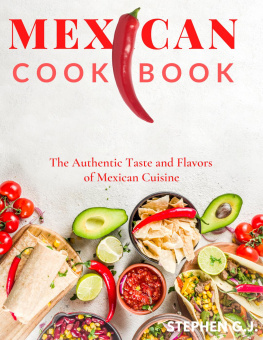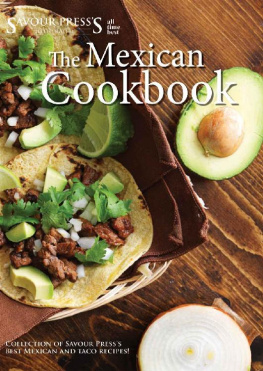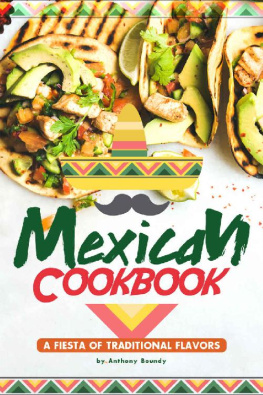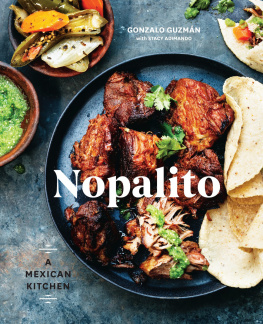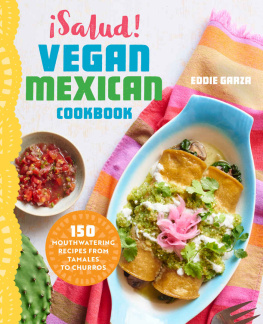Recent Titles in The Global Kitchen
Food Cultures of the United States: Recipes, Customs, and Issues
Bruce Kraig
Food Cultures of Israel: Recipes, Customs, and Issues
Michael Ashkenazi
Food Cultures of France: Recipes, Customs, and Issues
Maryann Tebben
FOOD CULTURES OF MEXICO
Recipes, Customs, and Issues
R. Hernandez-Rodriguez
The Global Kitchen

Copyright 2021 by ABC-CLIO, LLC
All rights reserved. No part of this publication may be reproduced, stored in a retrieval system, or transmitted, in any form or by any means, electronic, mechanical, photocopying, recording, or otherwise, except for the inclusion of brief quotations in a review, without prior permission in writing from the publisher.
Library of Congress Cataloging-in-Publication Data
Names: Hernndez Rodrguez, Rafael, 1963- author.
Title: Food cultures of Mexico : recipes, customs, and issues / R. Hernandez-Rodriguez.
Description: Santa Barbara, California : Greenwood, an imprint of ABC-CLIO, 2021. | Series: The global kitchen | Includes bibliographical references and index.
Identifiers: LCCN 2021009221 (print) | LCCN 2021009222 (ebook) | ISBN 9781440869235 (cloth) | ISBN 9781440869242 (ebook)
Subjects: LCSH: Food habitsMexico. | Cooking, Mexican. | MexicoSocial life and customs.
Classification: LCC GT2853.M6 H49 2021 (print) | LCC GT2853.M6 (ebook) | DDC 394.1/20972dc23
LC record available at https://lccn.loc.gov/2021009221
LC ebook record available at https://lccn.loc.gov/2021009222
ISBN:978-1-4408-6923-5 (print)
978-1-4408-6924-2 (ebook)
252423222112345
This book is also available as an eBook.
Greenwood
An Imprint of ABC-CLIO, LLC
ABC-CLIO, LLC
147 Castilian Drive
Santa Barbara, California 93117
www.abc-clio.com
This book is printed on acid-free paper 
Manufactured in the United States of America
The publisher has done its best to make sure the instructions and/or recipes in this book are correct. However, users should apply judgment and experience when preparing recipes, especially parents and teachers working with young people. The publisher accepts no responsibility for the outcome of any recipe included in this volume and assumes no liability for, and is released by readers from, any injury or damage resulting from the strict adherence to, or deviation from, the directions and/or recipes herein. The publisher is not responsible for any readers specific health or allergy needs that may require medical supervision, nor for any adverse reactions to the recipes contained in this book. All yields are approximations.
For Rosi, Gaby, and Doa Esther Rodrguez
Contents
Series Foreword
Imagine a typical American breakfast: bacon, eggs, toast, and home fries from the local diner. Or maybe a protein-packed smoothie, sipped on the go to class or work. In some countries in Europe, breakfast might just be a small cookie and a strong coffee, if anything at all. A South African breakfast might consist of a bowl of corn porridge with milk. In Japan, breakfast might look more like dinner, complete with rice, vegetables, and fish. What we eat varies from country to country, and even region to region. The Global Kitchen series explores the cuisines of different cultures around the world, from the history of food and food staples to main dishes and contemporary issues. Teeming with recipes to try at home, these volumes will delight readers by discovering other cultures through the lens of a treasured topic: food.
Each volume focuses on the culinary heritage of one country or one small group of countries, covering history and contemporary culture. Volumes begin with a chronology of major food-related milestones and events in the area, from prehistory to present. Chapters explore the key foods and meals in the country, covering the following topics:
- Food History;
- Influential Ingredients;
- Appetizers and Side Dishes;
- Main Dishes;
- Desserts;
- Beverages;
- Holidays and Special Occasions;
- Street Food and Snacks;
- Dining Out; and
- Food Issues and Dietary Concerns.
Chapters are textual, and each chapter is accompanied by numerous recipes, adding a hands-on component to the series. Sidebars, a glossary of important terms, and a selected bibliography round out each volume, providing readers with additional information and resources for their personal and scholarly research needs.
Whether readers are looking for recipes to use for classes or at home, or to explore the histories and traditions of world cuisines, the Global Kitchen series will allow readers to fully immerse themselves in other cultures, giving a taste of typical daily life and tradition.
Introduction
Mexican food in the United States has become so ubiquitous that it seems almost impossible to imagine a time when tacos, nachos, quesadillas , burritos, or guacamole were not a staple of the American diet and regular fare at restaurants and diners across the nation. Mexican restaurants are also part of our everyday life not only in big cities like New York, San Francisco, and Los Angeles but practically in any town in our nation. Mexican foodor Mexican-inspired food, ratheris an intrinsic part of the American culture that not only visually dominates the urban landscape with billboards, restaurant signs, and taco trucks, but it has entered our vernacular in phrases like the whole enchilada, holy guacamole, or Montezumas revenge. From chain restaurants, to authentic eateries, to fine dining establishments, Mexican food seems as American as, well, pie de manzana .
Part of the success of this cuisine is its proximity; part of its charm is its exoticism, at least to the average Americanit is all those colorful margaritas; the spicy tacos that awake our taste buds; those restaurants covered with sombreros and multicolored piatas hanging from the ceiling; the walls exhibiting riveting paintings of tiny villages and fields of agave and cactus plants; the smells of grilled meat and corn tortillas floating our way every time a waitress passes by our table with somebody elses order or when a basket of chips and salsa is presented to us as a welcoming offer; it is the loud and festive mariachi music, as well as the fluorescent palm trees. But Mexican food is much more than that. It is a cuisine that can trace its roots thousands of years back; a cuisine that emerged from the encounter of Native American and European cultures and evolved for over five centuries of mixing gastronomies and traditions; a cuisine that helped Mexicans to reaffirm their identity when the nation became independent from Spain; a cuisine that connected deeply with the people and became truly national after a bloody revolution; a cuisine that transformed itself during the twentieth century and transcended its borders to become a world cuisine known in other nations and other continents.
A cuisine that as a crowning achievement boasts being the first one to be recognized by United Nations Educational, Scientific and Cultural Organization (UNESCO) as an intangible cultural heritage of the world, which for some disingenuous people, confirms the importance of Mexican food around the world. This is a monumental achievement, no doubt, but it begs the question, why not Italian, or French, or Peruvian food? After all, Mexican food is neither the most sophisticated in the world nor the most aristocratic or even the most diverse and better tasting. These aspects are all a matter of personal predilection, certainly; however, they help us to point what is essential about Mexican food without disregarding its creativity and its importance for our tastebuds. And this is exactly what UNESCO acknowledged when considering Mexican food as a candidate for cultural world heritage and what convinced them in the end that it was a cuisine worth being preserved: its importance for Mexican cultural identity.
Next page


